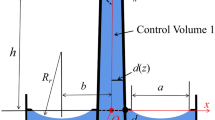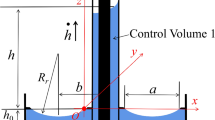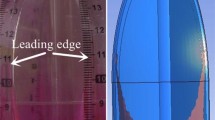Abstract
Owing to the development of the space exploration activities, the in-orbit management of fluids such as the transportation of propellant liquid in microgravity becomes the important direction of microgravity fluid research, and one of main problems is the stability behaviors of free surface flow in capillary channel of PMD. In the present study, an experiment set-up of the fluid transport with two different capillary channels has been developed on the Beijing Drop Tower platform. Both symmetrical and asymmetrical flow channels, with the same cross-sectional areas and lengths and different cross-sectional geometries were used and HFE-7500 is chosen as test liquid. 10 times of the drop-down experiments were performed for investigation of the capillary flow characters in different volumetric flow rates, and the three main patterns of capillary flows: subcritical flow, critical flow and supercritical flow were found in experiments, these patterns are distinguished by the movement of the point of lowest surface over time. Meanwhile, the critical flow rates at which free surface becomes instable observed in our experiments are (1) 2.7 ±0.2ml/s for the critical flow rate of asymmetrical channel; and (2) 2.2 ±0.2ml/s for symmetrical channel flow, respectively.












Similar content being viewed by others
References
Rollins, J. R., Grove, R. K., Jaekle, D. E.: Twenty-three years of surface tension propellant management system design, development, manufacture, test, and operation. AIAA Paper No, 85–1199 (1985)
Haeberle, S., Zengerle, R.: Microfluidic platforms for lab-on-a-chip applications. Lab Chip 7, 1094–1110 (2007)
Jaekle, D. E.: Propellant management device conceptual design and analysis: Vanes. AIAA Paper No, 91–2172 (1991)
Rosendahl, U., Ohlhoff, A., Dreyer, M. E.: Investigation of forced liquid flows in open capillary channels. Microgravity sci. Technol. 4, 53–60 (2002)
Conrath, M., Canfild, P. J., Bronowicki, P. M., Dreyer, M. E., Weislogel, M. M., Grah, A.: Capillary channel flow experiments aboard the international space station. Phys. Rev. E 88, 1–8 (2013)
Haake, D., Rosendahl, U., Ohlhoff, A.: Flow rate limitation in open capillary channel flows. Interdisciplinary Transport Phenomena in the Space Sciences 1077, 443–458 (2006)
Klatte, J.: Capillary Flow and Collapse in Wedge-Shaped Channels. University of Bremen, Bremen, Germany (2011)
Canfild, P. J., Bronowicki, P. M., Chen, Y., Kiewidt, L., Grah, A., Klatte, J., Jenson, R., Blackmore, W., Weislogel, M. M., Dreyer, M. E.: The capillary channel flow experiments on the international space station: Experiment set-up and fist results. Exp. Fluids 54, 1–14 (2013)
Rosendahl, U., Ohlhoff, A., Dreyer, M. E.: Choked flows in open capillary channels: Theory, experiment and computations. J. Fluid Mech. 518, 187–214 (2004)
Rosendahl, U., Grah, A., Dreyer, M. E.: Convective dominated flows in open capillary channels. Phys. Fluids 22, 1–13 (2010)
Wei, Y. X., Chen, X. Q., Huang, Y. Y.: Flow rate limitation in open wedge channel under microgravity. Sci. China Phys. Mech. Astron. 56(8), 1551–1558 (2013)
Haake, D., Klatte, J., Grah, A., Dreyer, M. E.: Flow rate limitation of steady convective dominated open capillary channel flows through a groove. Microgravity Science And Technology 22, 129–138 (2010)
Grah, A., Dreyer, M. E.: Dynamic stability analysis for capillary channel flow: One-dimensional and three-dimensional computations and the equivalent steady state technique. Phys. Fluids 22, 1–11 (2010)
Bronowicki, P. M., Canfild, P. J., Grah, A., Dreyer, M. E.: Free surfaces in open capillary channels-Parallel plates. Phys. Fluids 27, 1–21 (2015)
Acknowledgments
This research was financially supported by National Natral Science Foundation of China (Grants No.11532015), China National High-tech R&D Program and the Strategic Priority Research Program on Space Science, the Chinese Academy of Sciences
Author information
Authors and Affiliations
Corresponding author
Additional information
This article belongs to the Topical Collection: Advances in Gravity-related Phenomena in Biological, Chemical and Physical Systems Guest Editors: Valentina Shevtsova, Ruth Hemmersbach
Rights and permissions
About this article
Cite this article
Chen, X.L., Gao, Y. & Liu, Q.S. Drop Tower Experiment to Study the Capillary Flow in Symmetrical and Asymmetrical Channels: Experimental Set-up and Preliminary Results. Microgravity Sci. Technol. 28, 569–574 (2016). https://doi.org/10.1007/s12217-016-9512-y
Received:
Accepted:
Published:
Issue Date:
DOI: https://doi.org/10.1007/s12217-016-9512-y




